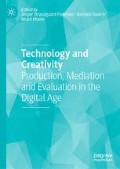Abstract
Technologyand creativity seem to be two core constructs that have dominated recent debates for understanding the driving forces in twenty-first-century economies, and in particular capitalist economies, debated under such terms as ‘ExperienceEconomy’ (Pine & Gilmorein The Experience Economy. Harvard Business School Press, Boston, MA, 1999) or ‘Name Economy’ (Moeran in Anthropological perspectives on economic development and integration. Elsevier, Amsterdam, pp. 299–321, 2003) or the more general term ‘New Economy’ to mention but a few of the terms coined.
Access this chapter
Tax calculation will be finalised at checkout
Purchases are for personal use only
References
Amabile, T. (1996). Creativity in context: Update to the social psychology of creativity. Boulder, CO: Westview Press.
Becker, H. S. (1982). Art Worlds. Berkeley and Los Angeles, CA: University of California Press.
Caves, R. (2000). Creative industries: Contracts between art and commerce. Cambridge, MA: Harvard University Press.
Christensen, B. T., & Strandgaard Pedersen, J. (2013). Restaurant rankings in the culinary field. In B. Moeran & B. T. Christensen (Eds.), Exploring creativity: Evaluative practices in innovation, design and the arts (pp. 235–259). Cambridge: Cambridge University Press.
Csikszentmihalyi, M. (1999). Creativity. New York: HarperCollins.
Ferguson, P. (1998). A cultural field in the making: Gastronomy in 19th-century France. American Journal of Sociology,104, 597–641.
Ferguson, P. (2004). Accounting for Taste: The triumph of French cuisine. Chicago: University of Chicago Press.
Hirsch, P. M. (1972). Processing fads and fashions: An organization-set analysis of cultural industry systems. American Journal of Sociology,77, 639–659.
Hirsch, P. M., & Gruber, D. A. (2015). Digitizing fads and fashions. In C. Jones, M. Lorenzen, & J. Sapsed (Eds.), The Oxford handbook of creative industries (pp. 420–436). Oxford, UK: Oxford University Press.
Jones, C., Lorenzen, M., & Sapsed, J. (2015). The Oxford handbook of creative industries. Oxford, UK: Oxford University Press.
Khaire, M. (2017). Culture and commerce: The value of entrepreneurship in creative industries. Stanford, CA: Stanford University Press.
Lampel, J., Lant, T. K., & Shamsie, J. (2000). Balancing act: Learning from organizing practices in cultural industries. Organization Science,11, 263–269.
Lampel, J., Shamsie, J., & Lant, T. K. (2006). Towards a deeper understanding of cultural industries. In J. Lampel, J. Shamsie, & T. K. Lant (Eds.), The business of culture: Strategic perspectives on entertainment and media. London: Lawrence Erlbaum Associates, Publishers.
Lane, C. (2014). The cultivation of taste: Chefs and the organization of fine dining. Oxford: Oxford University Press.
Moeran, B. (2003). Celebrities and the name economy. In Anthropological perspectives on economic development and integration (Vol. 22, pp. 299–321). Amsterdam: Elsevier.
Moeran, B., & Christensen, B. T. (Eds.). (2013). Exploring creativity: Evaluative practices in innovation, design, and the arts. Cambridge: Cambridge University Press.
Müller, F. H. (2018). When valuators are valuated: An analysis of the perception and description of valuation devices in fine-dining (Doctoral dissertation). Retrieved from Doctoral School of Organization and Management Studies, Copenhagen Business School.
Munar, A. M., & Gyimóthy, S. (2013). Critical digital tourism studies. In A. M. Munar, S. Gyimóthy, & L. Cai (Eds.), Tourism social media: Transformations in identity community and culture (Vol. 18, pp. 245–262). Emerald: Bingley.
Munar, A. M., Gyimóthy, S., & Cai, L. (Eds.). (2013). Tourism social media: Transformations in identity, community and culture. Emerald: Bingley.
Pine, J. B., & Gilmore, J. H. (1999). The experience economy. Boston, MA: Harvard Business School Press.
Rao, H., Monin, P., & Durand, R. (2005). Border Crossing: Bricolage and the erosion of categorical boundaries in French gastronomy. American Sociological Review,70(6), 968–991.
Runco, M. A. (2004). Creativity. Annual Review of Psychology,55, 657–687.
Slavich, B., & Castellucci, F. (2016). Wishing upon a star: How apprentice-master similarity, status and career stage affect critics’ evaluations of former apprentices in the haute cuisine industry. Organization Studies,37(6), 823–843.
Svejenova, S., Mazza, C., & Planellas, M. (2007). Cooking up change in haute cuisine: Ferran Adrià as an institutional entrepreneur. Journal of Organizational Behavior,28(5), 539–561.
Trubek, A. B. (2000). Haute cuisine: How the French invented the culinary profession. Philadelphia, PA: University of Pennsylvania Press.
Author information
Authors and Affiliations
Corresponding author
Editor information
Editors and Affiliations
Rights and permissions
Copyright information
© 2020 The Author(s)
About this chapter
Cite this chapter
Strandgaard Pedersen, J., Slavich, B., Khaire, M. (2020). Technology and Creativity: Production, Mediation and Evaluation in the Digital Age. In: Strandgaard Pedersen, J., Slavich, B., Khaire, M. (eds) Technology and Creativity. Palgrave Macmillan, Cham. https://doi.org/10.1007/978-3-030-17566-5_1
Download citation
DOI: https://doi.org/10.1007/978-3-030-17566-5_1
Published:
Publisher Name: Palgrave Macmillan, Cham
Print ISBN: 978-3-030-17565-8
Online ISBN: 978-3-030-17566-5
eBook Packages: Business and ManagementBusiness and Management (R0)

